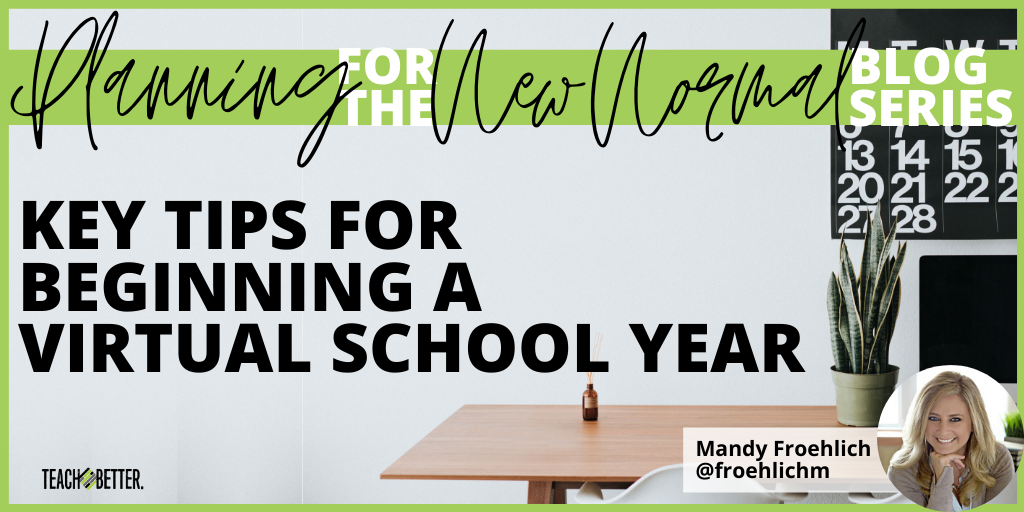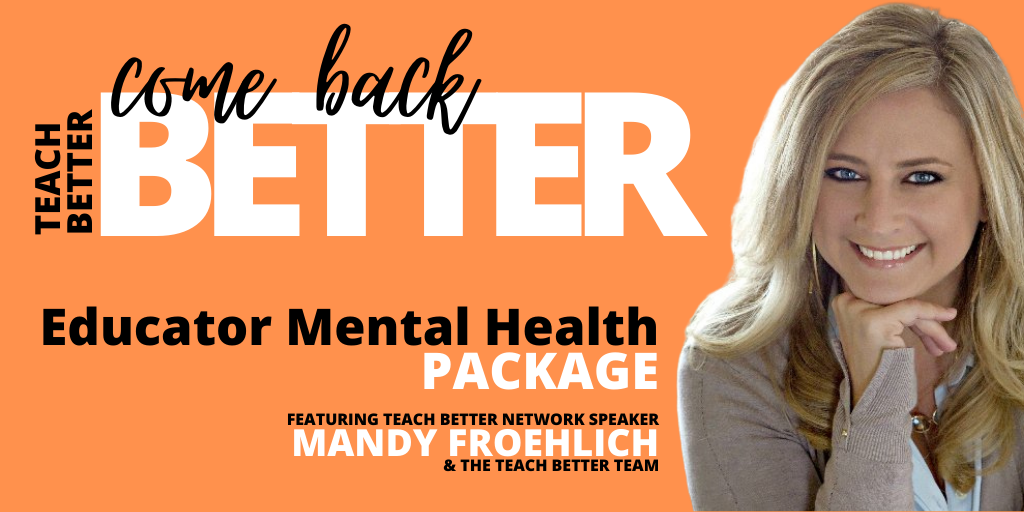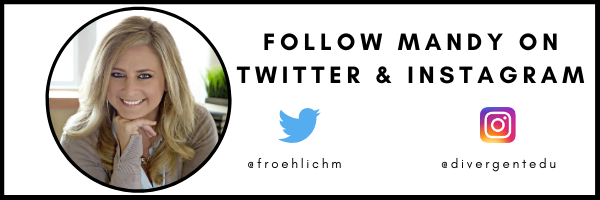TL;DR:
- Contacting your local mental health community partner is a strategy to start addressing mental heath in your school.
- Increase the effectiveness of online learning by using learning management systems, personalized learning, creating relationships online, and incorporating social-emotional learning.
- A technique for transforming your student relationship building activities to a virtual setting is shared.
As districts begin to finalize their start-up plans for the 20-21 school year, many of them include either beginning with virtual learning or a contingency plan that moves the brick-and-mortar classroom quickly online if necessary. Truthfully, if a district is not planning any kind of virtual option, they’re not planning well. While everyone did the best they could when the pandemic hit, we have now had a little bit of time to plan and try to think ahead. Whether this means asking what does virtually mean? Or using resources that will help make your lessons better. Or getting advice from other teachers, it doesn’t matter. You just need to make sure you’re prepared.
The number of decisions that administrators are making right now are astronomical, and with delays in some state governments coming out with plans, everything feels up in the air and is changing from day-to-day.
Nobody has the answers right now because we are living in unprecedented times. I can, however, point out some areas of concern that I feel are often overlooked in discussions about beginning this next school year.
Student relationships are still the most important part of our jobs even if they are created and maintained virtually. Our students need us more than ever. Click To TweetA Focus on Mental Health
To say that a focus on mental health is imperative would be the understatement of the century right now. Teachers are again leaving the profession at a record rate because they don’t feel safe in their classrooms and they, perhaps, did not get into teaching to do it online.
The state of overwhelm is real. Because there is so much uncertainty, our safety net of predictability is gone. The summer that previously allowed educators to catch their breath is now forcing them to continue to hold it until they know what’s happening.
Some educators need to make the choice between feeling safe or making money and keeping their job. There doesn’t seem to be a good solution to this, and we know what fear does. Fear breeds hostility. It breeds anger. And it breeds disengagement.
Students may also be feeling emotions that they have a difficult time describing. Recently, I watched a video called Numb by Liv McNeill that my friend Jennifer Casa-Todd posted on her blog. Even if you believe you understand what is happening with our students, I encourage you to watch it anyway. While their concerns—graduation, prom, sports, clubs—may seem small in the grand scheme of things, their entire lives are on hold and they have even less control over what is happening than adults do.
Tip #1 for Beginning a Virtual School Year: Mental Health Support
Many students are struggling, and for good reason. They are going to need mental health support before we can expect them to be concerned about the content of our classes.
I find that many districts don’t address mental health because they don’t know where to start. Here’s the simplest tip I can give: call your local mental health community partner. Ask them how you can begin to address mental health for staff and students. Check the district insurance. How can you make it easier for staff to get help?
And finally, do not subscribe to the idea that purchasing a ready-made social-emotional learning curriculum is the same thing as addressing mental health. Get to know what the terms mean and it will be the beginning of learning what needs to be done for true support.
Tip #2 for Beginning a Virtual School Year: Preparing for Teaching and Learning Online
My hope is that during the summer, districts have been offering professional learning opportunities in best practices for teaching and learning online. I understand that at the beginning we did whatever we could, and I maintain that I have never been prouder to call myself an educator than when I watched educators all over pivot in order to do what was best for students.
Whatever was done then was done with best intentions, and I applaud the entire profession for that. However, we’ve had time to reflect and we can do better.
In providing professional learning opportunities in best practices, using learning management systems, online assessment, personalized learning (including voice, choice, and pacing options), creating relationships online, incorporating social-emotional learning online, and so on, we can increase the effectiveness of the online learning opportunities that we create.
I’ve seen the “online learning doesn’t work” articles, but in order to make an intelligent determination as to if it works, we would have had to, as a whole, been doing true online teaching. In many cases, although people were doing the best they could, we weren’t. Now we have been afforded the opportunity of a little time to prepare.
Also, from the standpoint of educator mental health, it can be supported by providing these kinds of professional learning opportunities to them. It gives them the confidence in knowing that they are doing the best that they can online according to research-based practices. They may feel less like they are floundering and unsure, which increases their feelings of safety and efficacy.
[scroll down to keep reading]Tip #3 for Beginning a Virtual School Year: Keep Student Relationships at the Forefront
It’s so easy to get lost in the distribution of content and instruction in online learning. There is so much planning and forethought in good online teaching that it can consume one’s time and energy. However, student relationships are still the most important part of our jobs even if they are created and maintained virtually.
Our students need us more than ever.
For some of them, we have always been the adults in their lives that they could count on. It is not the same kind of feeling online for many of them.
One of the activities that I love to do when I work with school districts in beginning virtual programs or charters is to have educators write down all the ways that they create relationships in a brick-and-mortar setting. This seems hokey, but I’ve found that people are surprised by what they come up with. Not necessarily best practices for relationships, but the ways that individual teachers make students feel special and create connection. Maybe it’s eating lunch in the lunchroom, or chatting with students in the hall during passing. Maybe it’s using storytelling as a vehicle to teach, or using humor to catch their attention.
No matter what, write them all down. Then, circle the top three ways you prefer to create relationships. These will be the ways that fill your own cup as well. Finally, research tools and be creative in how you can recreate those relationship builders online. After all, these are the connections that the students remember most, no matter the content area you teach.
Tip #4 for Beginning a Virtual School Year: Make Decisions with Love
There are a million tips that anyone could provide a district with regarding starting up the 20-21 school year, and many of them would be solid suggestions in this time of uncertainty.
However, my final tip is this: Stop what you’re doing. Take a deep breath. Look at your colleagues. Look at your own children or spouses. People are overwhelmed and tired. Make decisions that you would want other people to make for your own family. If your choices are always human-centered and made with love, they can’t be wrong.
About Mandy Froehlich
Mandy Froehlich passionately encourages educators to create innovative change in their classrooms. Mandy is a former Director of Innovation and Technology, technology integrator, and teacher. She has experience at many levels of the organizational structure. Her interest lies in reinvigorating and re-engaging teachers back into their profession. She focuses on what’s needed to support teachers in their pursuit of innovative and divergent thinking and teaching.
She consults internationally with school districts and post-secondary institutions in the effective use of technology to support great teaching, mental health support for educators, and how to create organizational change.
Her first book, The Fire Within: Lessons from defeat that have ignited a passion for learning, discusses mental health awareness for teachers. Divergent EDU, her second book, is based on an organizational structure she developed to support teachers in innovative and divergent thinking. Reignite the Flames, her third book, based on educator engagement and mental health, is her most recent release.




